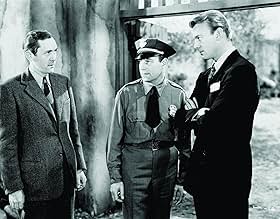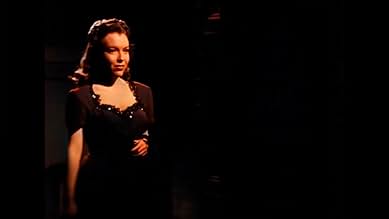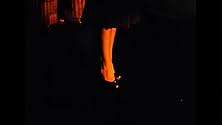IMDb-BEWERTUNG
6,7/10
6344
IHRE BEWERTUNG
Füge eine Handlung in deiner Sprache hinzuA seemingly-tame leopard used for a publicity stunt escapes and kills a young girl, spreading panic throughout a sleepy New Mexico town.A seemingly-tame leopard used for a publicity stunt escapes and kills a young girl, spreading panic throughout a sleepy New Mexico town.A seemingly-tame leopard used for a publicity stunt escapes and kills a young girl, spreading panic throughout a sleepy New Mexico town.
- Regie
- Drehbuch
- Hauptbesetzung
- Auszeichnungen
- 2 Nominierungen insgesamt
Tuulikki Paananen
- Consuelo Contreras
- (as Tula Parma)
Ed Agresti
- Mexican Police Officer
- (Nicht genannt)
Robert Andersen
- Dwight Brunton
- (Nicht genannt)
Lulu Mae Bohrman
- Nightclub Patron
- (Nicht genannt)
Jack Chefe
- Nightclub Waiter
- (Nicht genannt)
David Cota
- Boy Singer
- (Nicht genannt)
Sidney D'Albrook
- Waiter Serving Helene and Dwight
- (Nicht genannt)
Rosita Delva
- Young Lover
- (Nicht genannt)
Jacqueline deWit
- Helene
- (Nicht genannt)
John Dilson
- Coroner
- (Nicht genannt)
Empfohlene Bewertungen
Slimly-plotted but handsomely-produced second-biller about an escaped leopard in a small dirt town in New Mexico that may be the cause of several horrific deaths...or maybe not! Intriguing premise given stylish film-noir treatment. Performances are solid, and Jacques Tourneur's crafty direction allows viewers to see just enough before fading to black. Val Lewton produced, giving the proceedings his customary spooky polish; Roy Webb's background score is predictably dramatic, though the intermittent use of dead silence is even more effective (and the castanets were a nice touch). Story tails off near the end, but film is still a minor gem. Fantastically atmospheric and fun. Based on the book "Black Alibi" by Cornell Woolrich. *** from ****
The escape of nightclub performer's leopard is followed by a series of mutilations--but are these the work of the leopard or of a serial killer stalking a small southwestern town? Although not one of producer Val Lewton's better known films, director Tourner endows the story with considerable atmosphere, and the result is a moody and intriguing film that holds it own with the more celebrated CAT PEOPLE and I WALKED WITH A ZOMBIE.
Like other Lewton films, THE LEOPARD MAN relies more upon what it suggests than upon what it actually shows. This film is particularly effective in building suspense in a series of scenes that show various characters walking--a saucy Spanish dancer strolling along the street, a frightened teenager making a night-time trip to the grocer, a young woman rushing through a cemetery at night. The cinematography is elegant in its simplicity, and the sound design is quite remarkable. Hard to find, but Lewton fans will find it worth seeking out.
Gary F. Taylor, aka GFT, Amazon Reviewer
Like other Lewton films, THE LEOPARD MAN relies more upon what it suggests than upon what it actually shows. This film is particularly effective in building suspense in a series of scenes that show various characters walking--a saucy Spanish dancer strolling along the street, a frightened teenager making a night-time trip to the grocer, a young woman rushing through a cemetery at night. The cinematography is elegant in its simplicity, and the sound design is quite remarkable. Hard to find, but Lewton fans will find it worth seeking out.
Gary F. Taylor, aka GFT, Amazon Reviewer
Is Jacques Tourneur the laziest director ever? He let the audience do all the work. At least he did when making little suspense programmers under producer Val Lewton, who headed RKO's second-feature unit in the wartime 1940s. Hamstrung by parsimonious budgets, they racked their brains for ways to make their movies look good and pack a wallop. Their solutions proved inspired, resulting in a string of classics The Cat People, The Leopard Man, I Walked With A Zombie that still rank among the moodiest, most memorable fright-films ever made (with different directors, Lewton oversaw The Seventh Victim and other distinctive works in the same vein). With The Leopard Man, Tourneur was handed a script that showed little promise; when he was finished with it, it shone with his distinctive black magic. That magic was to suggest rather than to show; to plant seeds in viewers' imaginations and let them grow.
In a sleepy New Mexico town that somehow supports a posh night club, publicity man Dennis O'Keefe gets an idea to promote an act by arranging for the star (Jean Brooks) to make a grand entrance with a big black leopard on a leash. The cat escapes and soon the deaths begin.
First a girl sent out into the night to fetch cornmeal for mama's tortillas finds the corner store closed and must venture further afield. Tumbleweeds stirred up by the dry winds and trains hurtling over trellises are unnerving enough, but then something else starts its pursuit. She almost makes it back safely but the lock is stuck....
Next another young woman sets off in late afternoon for an assignation with her boyfriend at the cemetery. When he doesn't show, she loses track of time and improvidently finds herself locked in among the gravestones and statuary....
A posse sets out to find and kill the leopard, but O'Keefe begins to doubt whether the killer is in fact feline. It's in the resolution (based on a story by Cornell Woolrich) that the script ultimately disappoints, but the trip to it remains a dark ride. Those minuscule budgets didn't compromise the movie's decadently glossy looks, and the extraordinary Roy Webb's castanet-ridden score keeps the tension taut (one high, sustained, almost pianissimo chord hangs over the cemetery scene). The mistress of the castanets, a cabaret dancer called Clo-Clo, is an actress called Margo; the ace of spades keeps turning up in her fortune. Her performance lends The Leopard Man what little heart it shows.
In a sleepy New Mexico town that somehow supports a posh night club, publicity man Dennis O'Keefe gets an idea to promote an act by arranging for the star (Jean Brooks) to make a grand entrance with a big black leopard on a leash. The cat escapes and soon the deaths begin.
First a girl sent out into the night to fetch cornmeal for mama's tortillas finds the corner store closed and must venture further afield. Tumbleweeds stirred up by the dry winds and trains hurtling over trellises are unnerving enough, but then something else starts its pursuit. She almost makes it back safely but the lock is stuck....
Next another young woman sets off in late afternoon for an assignation with her boyfriend at the cemetery. When he doesn't show, she loses track of time and improvidently finds herself locked in among the gravestones and statuary....
A posse sets out to find and kill the leopard, but O'Keefe begins to doubt whether the killer is in fact feline. It's in the resolution (based on a story by Cornell Woolrich) that the script ultimately disappoints, but the trip to it remains a dark ride. Those minuscule budgets didn't compromise the movie's decadently glossy looks, and the extraordinary Roy Webb's castanet-ridden score keeps the tension taut (one high, sustained, almost pianissimo chord hangs over the cemetery scene). The mistress of the castanets, a cabaret dancer called Clo-Clo, is an actress called Margo; the ace of spades keeps turning up in her fortune. Her performance lends The Leopard Man what little heart it shows.
Jerry Manning (Dennis O'Keefe) decides to build some PR for his girlfriend's act by having her walk into the bistro where she performs with a black leopard on a leash. Her rival, Clo-Clo, retaliates by getting close to the leopard and clicking her castanets. The leopard is scared, pulls free of Kiki, and runs off.
Later that night, a girl coming home from the grocery store is mauled and killed by the leopard. Then two more mauling deaths occur - one a young girl, one a young woman. The leopard's owner, Charlie How-Come, says that he can't figure out why the leopard would kill the second and third victims rather than hide out away from the town. Manning agrees with him, and they search for the truth of what is happening in these maulings.
This film is full of brief but indelible little characterizations tangential to the storyline. There's so often an emphasis on the primitive, uncontrollable sides of our nature, that gives a deeper feeling to the sometimes over-busy plotting.
There's some strange characterization going on here too, For example, the first victim is a victim precisely because she has the world's worst mom. First she sends the girl out late at night to get groceries, and then when she returns, terrified because the leopard is after her, mom teases her and won't unlock the front door. Mom's mood and sense of urgency doesn't change until she hears the girl scream and sees her blood pool under the front door. And mom has the nerve to wear black at the funeral.
Later that night, a girl coming home from the grocery store is mauled and killed by the leopard. Then two more mauling deaths occur - one a young girl, one a young woman. The leopard's owner, Charlie How-Come, says that he can't figure out why the leopard would kill the second and third victims rather than hide out away from the town. Manning agrees with him, and they search for the truth of what is happening in these maulings.
This film is full of brief but indelible little characterizations tangential to the storyline. There's so often an emphasis on the primitive, uncontrollable sides of our nature, that gives a deeper feeling to the sometimes over-busy plotting.
There's some strange characterization going on here too, For example, the first victim is a victim precisely because she has the world's worst mom. First she sends the girl out late at night to get groceries, and then when she returns, terrified because the leopard is after her, mom teases her and won't unlock the front door. Mom's mood and sense of urgency doesn't change until she hears the girl scream and sees her blood pool under the front door. And mom has the nerve to wear black at the funeral.
Dennis O'Keefe and Jean Brooks decide to elevate their act in New Mexico by having Brooks walk on-stage with a black leopard. The Mexican castanet dancer, Clo Clo(deliciously played by Margo), mashes the castanets menacingly at the cat, it flees, and a panic spreads amongst the people of the little village. Soon, one girl dies, then another, and another...and evidence points that a cat did it and later to something completely different. The Leopard Man is one of those rare films that is very effective with shadows and fog without showing anything. We never see any of the deaths happen "on-stage" so to speak. The imaginations of the viewers are enlisted to conjure up what might be the scene of each murder. Director Jacques Tournier and producer Val Lewton probably team up for their best collaboration. This film is laced with moody atmosphere, great pacing, quality performances, and a script worked over by the camera that enforces theme and symbolic meaning throughout. I found this film haunting, eerie, and poetic in its own way. O' Keefe, James Bell, Margo, Brooks, and the entire cast give credible turns and enforce our ability to accept what is going on.Some scenes are quite memorable: the young girl walking back home from the store is a classic scene of terror, the cemetery scene, and the procession of the monks allowed Tournier to work his magic with the lens. Tournier was always able to tell so much story with so little dialog. Though some might find the ending a bit of a letdown, I thoroughly enjoyed The Leopard Man.
Wusstest du schon
- WissenswertesIn the Summer of 1952, RKO reissued this film as a double feature with King Kong und die weiße Frau (1933). RKO cashed in, as young theatergoers, due to this film's title, were expecting to see a second creature film.
- PatzerAt the nightclub, Kiki is seated at a table with Jerry and Galbraith. As she asks Galbraith why he gave up teaching, a slim dark-haired woman wearing a matching suit and hat walks past their table. The shot cuts to Galbraith saying 'Various reasons', and the woman can be seen behind him (just over his shoulder on the far left of the screen), already seated at a nearby table.
- Zitate
Charlie How-Come: You don't get the idea, mister. These cops banging those pans, flashing those lights, they're gonna scare that poor cat of mine. Cats are funny, mister. They don't want to hurt you, but if you scare them they go crazy. These cops, they don't know what they're doing.
- Alternative VersionenSome older TV prints of "The Leopard Man" run 59 minutes.
- VerbindungenFeatured in Terror on Twelve: The Leopard Man (1964)
- SoundtracksLas Mañanitas
(uncredited)
Traditional Mexican birthday song
Performed by Fely Franquelli and Ottola Nesmith
Top-Auswahl
Melde dich zum Bewerten an und greife auf die Watchlist für personalisierte Empfehlungen zu.
Details
- Laufzeit
- 1 Std. 6 Min.(66 min)
- Farbe
- Seitenverhältnis
- 1.37 : 1
Zu dieser Seite beitragen
Bearbeitung vorschlagen oder fehlenden Inhalt hinzufügen
































